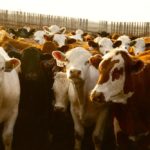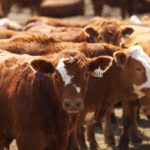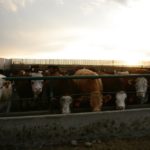Reading Time: 5 minutes Stress can have a big impact on calves and if not managed properly, freshly weaned calves heading to a feed yard can be very susceptible to pneumonia and other illnesses. While herd health veterinarians and feedlot production specialists can each have slightly different approaches to getting new feeders ramped up to the intended full-feed ration, […] Read more

The basics for handling freshly weaned calves at feedlots
Rest and getting them on feed and water are simple things but they take planning and management

Klassen: Feeder market digesting lower beef demand
Compared to last week, western Canadian yearling prices were down $12-$18; mid-weight calves were down $10 to as much as $15 while calves under 550 lbs. were down $4-$8. The market is incorporating a risk discount due to uncertainty in beef demand for the second and third quarters of 2020. Feedlot margins are in negative […] Read more

Klassen: Extreme variability characterizes feeder market
Western Canadian feeder cattle prices were extremely variable over the past week which made the market hard to define. Compared to last week, yearling prices were quoted $2 to as much $6 lower while calves traded $2 lower as much as $5 higher. While some auction crowds were caught up with the negative news coverage, […] Read more

Klassen: Coronavirus fears weigh on feeder markets
Western Canadian feeder prices were not immune to the meltdown of financial and commodity markets last week. Buyers appeared to incorporate a risk discount due to uncertainty in beef demand over the next few months. Compared to last week, larger groups of quality yearlings traded $3-$5 lower while smaller packages were down $4 to as […] Read more

Klassen: Calves remain firm while yearlings falter
Compared to last week, western Canadian yearling markets traded $3-$5 lower while calves and grassers traded within $5 on either side of unchanged. Calves were extremely variable with similar weight cattle sometimes trading $6-$8 apart at the same sale. Supplies of calves coming on the market appear to be lower than last year. This may […] Read more

Klassen: Calf prices divorce from yearling markets
Compared to last week, yearling prices were steady to as much as $4 lower depending on the region in Western Canada. Alberta packers were buying fed cattle at an average price of $252 on a dressed basis, down $6-$8 from last week and down about $20 from the last week of January. Weakness in fed […] Read more

Bovine brucellosis abortion screening pilot
Reading Time: < 1 minute The Canadian Food Inspection Agency and participating Canadian Animal Health Surveillance Network laboratories are conducting a pilot project to improve Canada’s bovine brucellosis surveillance. Blood and tissue samples related to reproductive issues in cattle submitted to participating network laboratories during this time may be tested for brucellosis at a CFIA laboratory. Brucellosis is a contagious […] Read more

Klassen: Uncertain beef demand weighs on feeder market
Compared to last week, western Canadian prices for yearling and heavier calves were down $2-$4 on average. The calf market was hard to define; Alberta markets traded $3 lower to $4 higher but notable strength was evident in Saskatchewan and Manitoba where values were steady to $4 higher. Favourable weather contributed to higher auction market […] Read more

Klassen: Feeder market remains under pressure
Compared to last week, western Canadian feeder cattle prices were steady to $3 lower in Alberta while prices eroded by $2-$5 in Saskatchewan and Manitoba. Noticeable weakness was evident in yearling prices, while grass cattle experienced limited slippage. Backgrounding operators are starting to liquidate fall-placed calves. Quality was quite variable, with fleshier cattle experiencing sharper […] Read more

Klassen: Feeder market lacks buying interest
Compared to last week, western Canadian feeder cattle markets traded $2-$5 lower on average. Values in Alberta were relatively unchanged but markets in the eastern Prairie regions appeared to trade $4 to as much as $6 below week-ago levels. Alberta yearlings were relatively unchanged, but noticeable slippage was noted in the non-major feeding regions. Feedlots […] Read more

